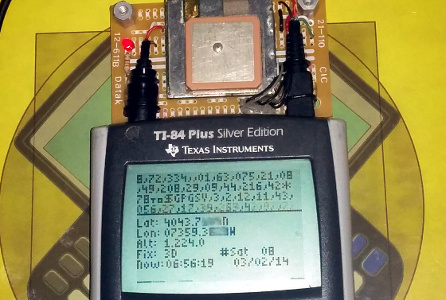GPS for Graphing Calculators
Published by KermMartian
10 years, 2 months ago (2014-02-04T17:45:38+00:00)
| Discuss this article
Graphing calculators are nothing less than powerful pocket computers, capable of doing many of the same things as smartphones, desktops, and laptops. Given that they have reasonably fast processors, a display, memory, and ports to interface with the outside world, I set out to making graphing calculators capable of determining their location using standard GPS hardware. I started with the TI-84 Plus / Silver Edition series of graphing calculators, which have a 15MHz processor, a 96x64-pixel monochrome screen, rudimentary timers (as well as one 32KHz crystal timer), and perhaps most importantly, two ports to interface with the outside world. One is a USB OTG port, a mini-USB port capable of acting as either a host or device, and therefore capable of producing 5V for peripherals. The other is a "serial" I/O port with two bidirectional TTL-level data lines. For my project, I chose to use the USB port for power, and the I/O port to communicate with a TTL serial GPS module. I created both the hardware and software necessary to make the project a reality, then suffered through two weeks of trying to get a GPS fix amid the metal canyons of a major US city.
Along the way, the two major technical challenges I faced were building a serial library and powering the module from the calculator. Once I succeeded in building functioning hardware and software, and eventually got a video of the GPS device operating normally, I documented the project in the writeup, video, and pictures linked below. Enjoy, and I challenge you to try building this project as well!
More Information
 GPS for graphing calculators documentation
GPS for graphing calculators documentation
 Video of TI-84+SE receiving GPS data
Video of TI-84+SE receiving GPS data
 GPS driver for TI-84+/SE
GPS driver for TI-84+/SE

Permalink
Graphing calculators are nothing less than powerful pocket computers, capable of doing many of the same things as smartphones, desktops, and laptops. Given that they have reasonably fast processors, a display, memory, and ports to interface with the outside world, I set out to making graphing calculators capable of determining their location using standard GPS hardware. I started with the TI-84 Plus / Silver Edition series of graphing calculators, which have a 15MHz processor, a 96x64-pixel monochrome screen, rudimentary timers (as well as one 32KHz crystal timer), and perhaps most importantly, two ports to interface with the outside world. One is a USB OTG port, a mini-USB port capable of acting as either a host or device, and therefore capable of producing 5V for peripherals. The other is a "serial" I/O port with two bidirectional TTL-level data lines. For my project, I chose to use the USB port for power, and the I/O port to communicate with a TTL serial GPS module. I created both the hardware and software necessary to make the project a reality, then suffered through two weeks of trying to get a GPS fix amid the metal canyons of a major US city.
Along the way, the two major technical challenges I faced were building a serial library and powering the module from the calculator. Once I succeeded in building functioning hardware and software, and eventually got a video of the GPS device operating normally, I documented the project in the writeup, video, and pictures linked below. Enjoy, and I challenge you to try building this project as well!
More Information
 GPS for graphing calculators documentation
GPS for graphing calculators documentation
 Video of TI-84+SE receiving GPS data
Video of TI-84+SE receiving GPS data
 GPS driver for TI-84+/SE
GPS driver for TI-84+/SE

Permalink
Advertisement

